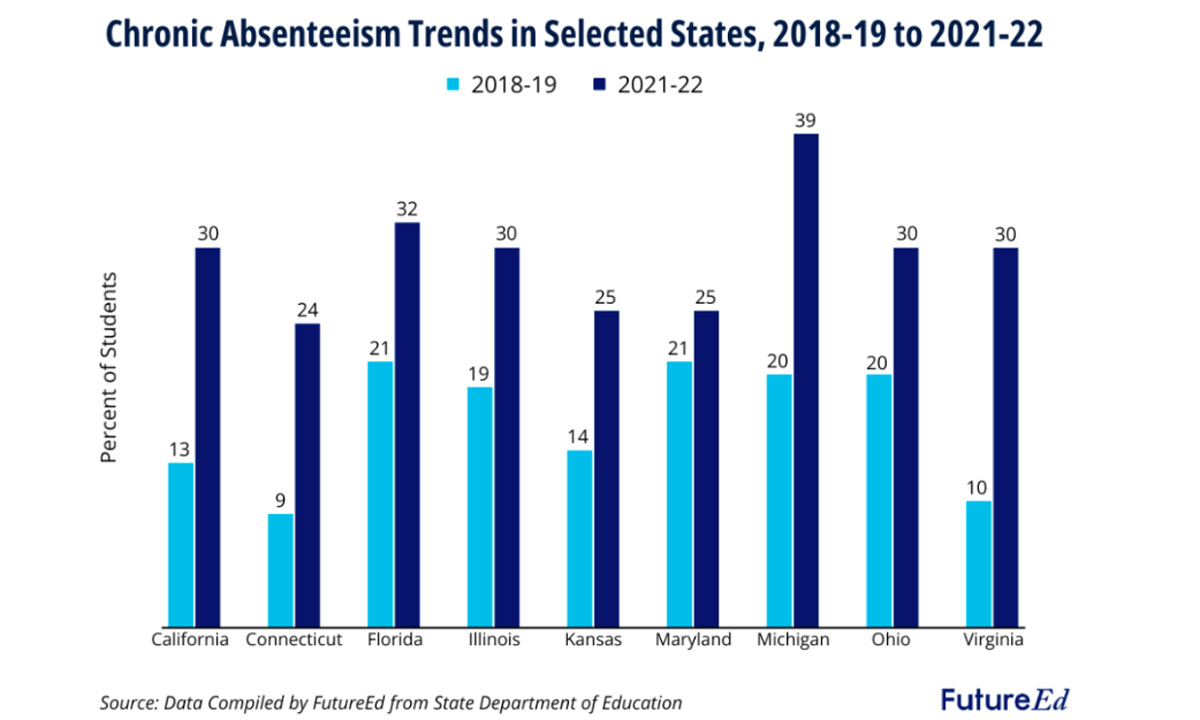Outdated Data on Chronic Absenteeism is Slowing Pandemic School Recovery
Cohen: In dozens of states, the most recent information is 15 months old. It raises the question: Are they delaying releasing unflattering stats?

Get stories like this delivered straight to your inbox. Sign up for The 74 Newsletter
This essay originally appeared at FutureEd.
Student testing at the national, state and local levels has given policymakers a clear, up-to-date picture of learning loss during the pandemic. But on another key recovery metric, student absenteeism, reporting has lagged badly in many states, making it difficult to know if the hundreds of millions of dollars and thousands of hours states and school districts have spent to get kids back in school are working, and if policymakers should continue to invest resources to bring down absenteeism rates that spiked during the pandemic.
One of the most surprising and least anticipated consequences of pandemic school disruption is that many students didn’t return to school when normal operations resumed. In many districts, chronic absenteeism — the number of students missing 10% or more of school days — increased in the 2021-22 school year from the previous year, even after schools were fully open and vaccines were widely available. Michigan, for example, saw its chronic absenteeism rate almost double, from 20% to 39%, during the pandemic. Virginia’s rate tripled, from 10% to 30%.
Long quarantines and other COVID protocols still enforced in 2021-22 undoubtedly contributed to the increases. But was 2021-22 an outlier, or part of a longer-term trend? In the absence of 2022-23 attendance data in many states, we don’t know. In at least 35 states, the most recent absenteeism information is now 15 months old.
In the relatively few states and school districts that have released more recent information, the results are mixed; absenteeism is improving in some places and worsening in others. In New Mexico, where the state has made detailed 2022-23 chronic absenteeism data publicly available on its Education Department website, the statewide chronic absenteeism rate has declined slightly in the past year, from a staggering 40% to 39%. Absenteeism rates in the Albuquerque school district declined from 46% in 2021-22 to 38% in 2022-23. Just 15 miles north, in Rio Rancho, however, the trend continues to move in the wrong direction, with chronic absenteeism rates rising from 24% in 2021-22 to 36% in 2022-23.

The same mixed picture exists in other jurisdictions that have reported numbers. Connecticut — a state that has dedicated millions of federal ESSER dollars to improving attendance through its Learner Engagement and Attendance Program that focuses on home visits — has released 2022-23 attendance data showing a decline in chronic absenteeism statewide. But Montgomery County Public Schools in Maryland and Oakland Unified School District in California both saw rates of chronic absenteeism continue to rise last year.

Knowing who’s in school post-pandemic and who isn’t is critical for legislators, local school board members and administrators, and states shouldn’t rely on thousands of local school districts to do the job. Tracking individual districts as they release data is inefficient. If Connecticut and New Mexico can produce 2022-23 attendance data in weeks, there’s no reason other states can’t do so.
Take Rhode Island. Recognizing that its traditional practice of reporting chronic absenteeism at the end of each school year “is often too late for schools and districts to help get students to school,” the state’s Department of Education has launched a Rhode Island Student Attendance Leaderboard that updates public reports on school-level attendance daily throughout the school year.
But too many states haven’t even announced when last year’s data will be available. South Carolina and the District of Columbia, for example, won’t release 2022-23 attendance data until November. It raises the question of whether states are deliberately slow-rolling unflattering information. If states like New Mexico and Connecticut have released encouraging absenteeism results, are other states withholding less encouraging news?
States that have released 2022-23 chronic absenteeism data as of Sept. 22, 2023: Colorado, Connecticut, Louisiana, Massachusetts, Nebraska, New Mexico, North Dakota, Ohio, Rhode Island, Virginia, West Virginia and Delaware.
Get stories like these delivered straight to your inbox. Sign up for The 74 Newsletter

;)
